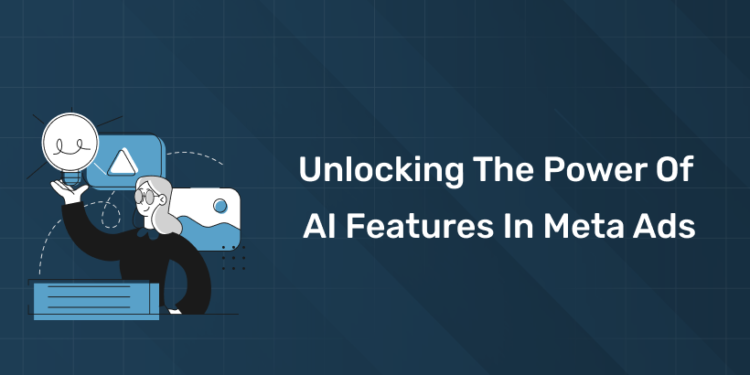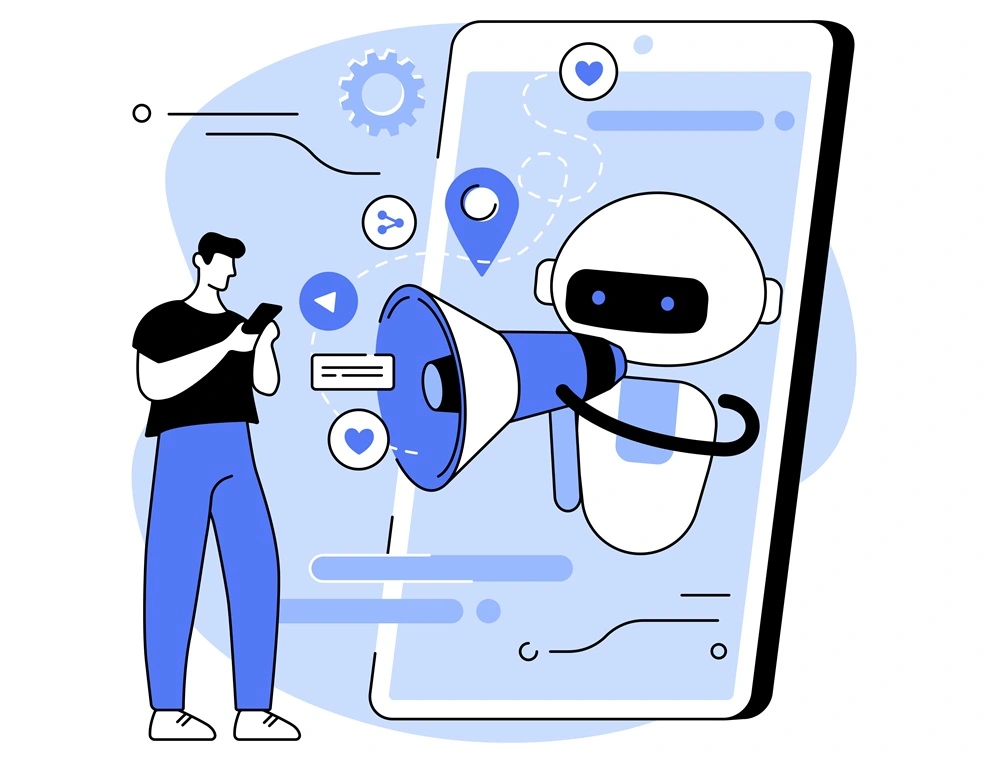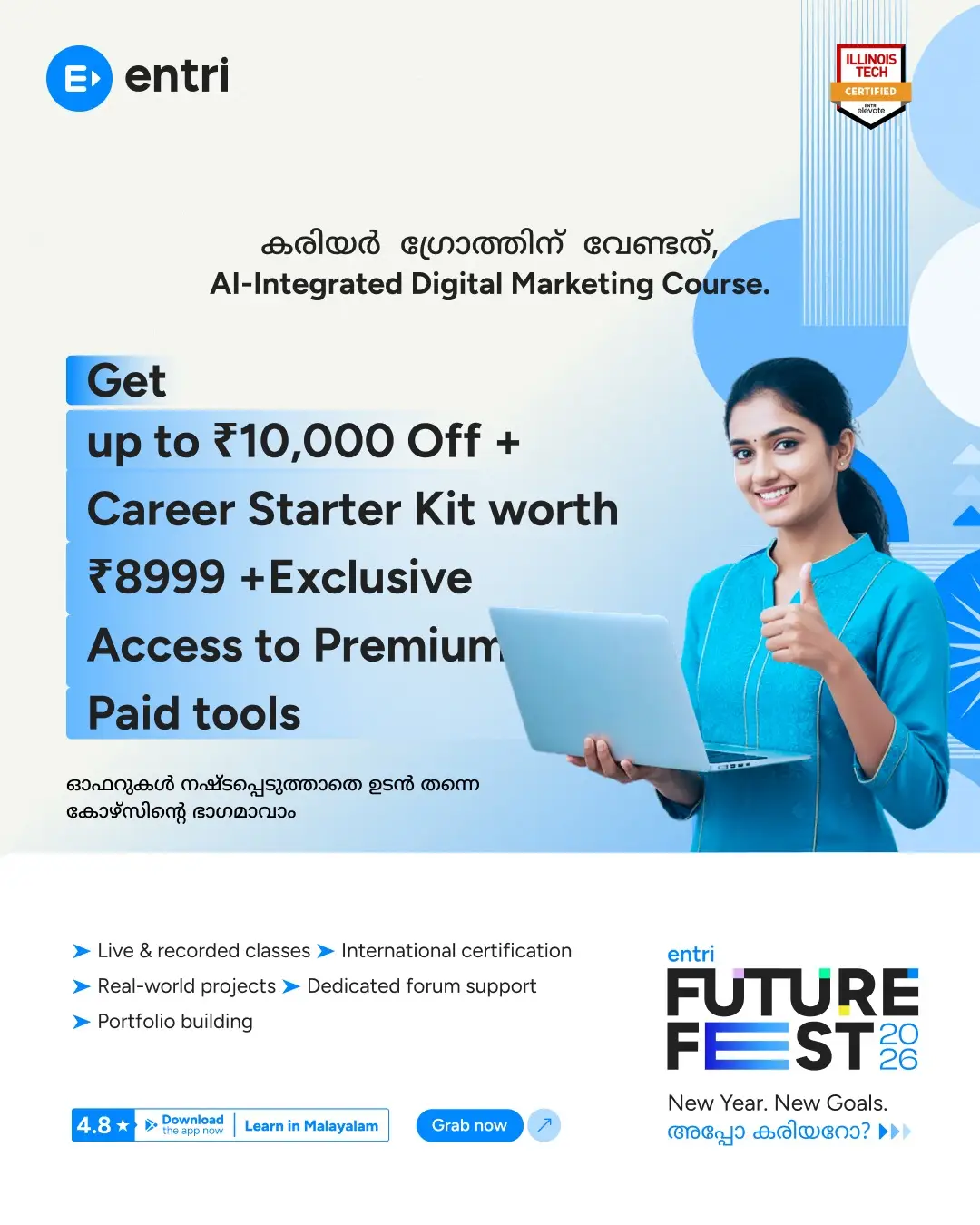Table of Contents
Introduction
Meta (Facebook & Instagram) has moved fast from manual campaign settings to AI-first ad products. In 2025, the platform introduced and expanded a suite of AI tools, collectively branded around Advantage+, generative creative features, automated audiences, and AI-powered lead-gen enhancements, all intended to help advertisers scale with less hands-on optimisation. For marketers in India, where digital ad budgets are growing and short-form social formats dominate, understanding these AI features isn’t optional, it’s essential.
This post explains the major AI features in Meta Ads, how they work, step-by-step usage guidance, what to watch out for, and how to upskill (including how Entri’s AI-powered digital marketing course can help you get practical with these tools). The aim is practical: after reading, you’ll know which AI features to try, how to measure them, and how to avoid common pitfalls.
Join Our Online Digital Marketing Course & Learn the Fundamentals!
What “AI in Meta Ads” really means
1: What is the primary goal of SEO (Search Engine Optimization)?
When Meta talks about AI for advertisers, it means three broad capabilities:
- Automation & optimisation: letting Meta’s machine-learning models decide who should see which creative, and when, to meet your campaign goal (e.g., conversions, installs). That’s the heart of Advantage+.
- Generative creative: AI tools that help generate or adapt images, videos and copy variations so advertisers can produce many creative variants fast. Meta has rolled these out to advertisers progressively.
- Audience & funnel intelligence: AI that builds audiences, predicts intent, auto-allocates budget across placements, and enriches lead-gen workflows (including verification and nurturing enhancements).
Put simply: Meta’s AI reduces manual work (target selection, bid setting, creative testing) and promises improved scale, but it also means ceding some control to platform algorithms.
Become an AI-powered Digital Marketing Expert
Master AI-Driven Digital Marketing: Learn Core Skills and Tools to Lead the Industry!
Explore CourseKey AI features in Meta Ads
Below are the AI features marketers encounter in Ads Manager today and what each does.
1. Advantage+ Campaigns (Advantage+ suite)
Advantage+ is Meta’s umbrella for automated campaigns that use ML to manage targeting, budget allocation, placements, and creative testing. It includes specialized flavours, Advantage+ Shopping, Advantage+ App, etc. These campaigns are designed to optimise toward a conversion objective with minimal manual tuning.
Why it matters: Saves setup time and can scale quickly for broad prospecting.
When to use: When you want to prioritise scale over tight manual control (e.g., broad product launches).
2. Advantage+ Creative (Generative & Optimization for Creatives)
Advantage+ Creative helps automatically create and test creative variations from uploaded assets, and Meta’s generative AI tools can assist with copy variations, resizing/adaptation, and, in some cases, generate visuals. This accelerates the creative testing loop.
Why it matters: Creative is the biggest lever for social ads, and automated creative testing speeds up discovering top-performing concepts.
When to use: For high-volume creative testing (D2C, e-commerce).
3. Automatic Placements & Advantage+ Placements
Meta’s AI determines the best placement (Feed, Reels, Stories, In-stream) and adjusts bids across placements to maximise conversions. Advantage+ Placements automates this with stronger ML signals.
Why it matters: Ensures your budget finds the most efficient inventory across Meta apps.
When to use: When you want a cross-placement scale and have a creative that adapts to multiple formats.
4. Generative AI for Creatives (images, video & copy)
Meta has begun rolling out generative tools in Ads Manager that help tailor ad visuals and text, and has announced broader availability to advertisers. These tools can adapt imagery to different ratios, create short video variants, and propose copy alternatives.
Why it matters: Significantly reduces creative production costs for small teams.
When to use: When you need many creative permutations quickly, but always review outputs for brand fit.
5. AI-powered Lead Gen & Verification
New AI features for lead-generation ads include improved targeting, verification and lead nurturing tools (automated follow-ups, intent scoring), making lead flows more reliable. Meta has begun updating Lead Ads with these capabilities.
Why it matters: Increases lead quality and reduces manual follow-up work.
When to use: For high-volume lead capture campaigns (education, real estate, finance).
6. Automated Bidding & Smart Bidding Strategies
AI bidding strategies (Target CPA, Maximise Conversions, ROAS) are now more advanced and integrated with Advantage+ setups. Meta’s ML uses historical and real-time signals to bid dynamically on impressions likely to convert.
Why it matters: Better bids without manual micro-management.
When to use: When you have sufficient conversion volume for models to learn (recommendation: ≥50 conversions/week for stable learning).
7. Business AI & AI Agents for Advertisers
Meta has been developing “Business AI” tools that act like assistants for SMBs, suggesting campaigns, creative improvements, and sales guidance. These agents aim to simplify ad operations for smaller advertisers. Recent product updates show Meta expanding Business AI features.
Why it matters: Democratizes advanced ad tactics for businesses without dedicated teams.
When to use: For SMBs and early-stage marketers testing paid social.
8. Data & Privacy Integrations: Conversions API, Clean Rooms & AI
AI is only as good as its data. Meta has expanded its server-side tracking and Conversions API guidance to feed first-party signals into models (vital after cookies). There are also clean room and verification tools to measure performance without exposing raw PII.
Why it matters: Better signal = better ML. Investment in first-party data is a prerequisite for reliable AI performance.
When to use: Always, especially when you rely on AI bidding and attribution.
How to use Meta’s AI features, practical step-by-step
Here’s a practical workflow to adopt Meta AI features without losing control:
Step 1: Start with clear business goals
Define the primary KPI (purchases, leads, installs). AI optimises to the signal you provide; if the signal is noise, results will be noisy.
Step 2: Ensure quality conversion tracking
Set up GTM / Conversions API and validate events. Reliable server-side events feed the AI models and reduce attribution errors.
Step 3: Run an Advantage+ pilot (small budget)
Run a 2–4 week Advantage+ test for prospecting with a controlled budget. Keep a parallel manual campaign to compare performance.
Step 4: Use Advantage+ Creative, but review outputs
Upload assets and enable Advantage+ Creative, but inspect every AI-generated variant. Meta’s generative outputs can surprise (see Risks below).
Step 5: Monitor frequency, brand safety, and KPIs daily
AI can scale quickly; make daily checks on creative resonance, brand appropriateness, and CPA. Set alerts for sudden creative changes.
Step 6: Use AI for scaling, keep manual control for niche audiences
For broad funnel acquisition, allow AI; for niche, high-value segments or nuanced messaging, prefer manual targeting.
Step 7: Incorporate learnings into creative briefs
Use the creative winners the AI discovers to brief your in-house or agency design teams for higher fidelity ads.
Best practices: what works
Do
- Use AI for scale and to generate volume of creatives for testing.
- Feed first-party conversion data (via Conversions API) to improve model learning.
- Keep a control campaign to benchmark performance vs fully automated setups.
- Maintain a creative review loop, human oversight for brand fit.
- Use AI-driven lead flows but validate leads server-side and via CRM match.
Don’t
- Set-and-forget AI: systems can drift if creative, offers or landing pages change.
- Enable all “automatic adjustments” unchecked, some advertisers reported the AI reactivating settings and producing off-brand creative. Always check automation toggles.
- Ignore data hygiene: inaccurate conversions create bad learning signals.
Become an AI-powered Digital Marketing Expert
Master AI-Driven Digital Marketing: Learn Core Skills and Tools to Lead the Industry!
Explore CourseMeasuring success: how to evaluate AI features
Use a structured measurement approach:
- A/B test Advantage+ vs manual on identical budgets and audiences. Compare CPA, ROAS, and conversion volume.
- Signal health checks: Monitor raw event volume before vs after Conversions API adoption.
- Creative lift tests: Use holdout audiences to estimate creative lift from AI-generated creatives.
- Brand safety monitoring: Use third-party verification and manual audits for ad creatives (especially when using generative AI).
When AI reduces CPA and increases scalable conversions, it’s working. But always triangulate with business metrics (revenue per user, return on ad spend, retention), not just conversion counts.
What this means for marketers and agencies
India’s digital market is unique: lower CPA thresholds, mobile-first behaviour, and massive short-form video consumption. Meta’s AI features (creative automation + Advantage+ for placements) match these trends: they enable rapid creative iteration for Reels and help scale ads across many small inventory pockets. Indian SMBs and local agencies stand to gain, but must learn a new skillset: data hygiene, first-party signal capture and creative governance.
For performance teams: focus on building pipelines that feed reliable conversion signals to Meta (Conversions API), setting creative guardrails, and documenting tests. For freelancers and job seekers: proficiency in Advantage+, GTM, GA4, and creative testing is now a premium skill.
Tools & workflows to pair with Meta AI features
- Server-side tracking & Conversions API: essential for good signal.
- Looker Studio / Supermetrics: build cross-channel dashboards to monitor AI campaigns.
- Creative libraries & versioning: use Figma/Canva + asset naming conventions to track AI variants.
- Experiment log: document A/B tests, significance, and creative learnings (internal wiki).
- 3rd-party verification: DoubleVerify/IAS for impression quality and brand safety when scaling.
Upskilling: how to learn and master these features
If you’re serious about applying Meta’s AI features professionally, focus on three clusters:
- Technical tracking & analytics: GTM, Conversions API, GA4, Looker Studio.
- AI-led creative testing: using Advantage+ Creative, building briefs from AI winners, and editing AI outputs.
- Campaign strategy with automation: how to blend Advantage+ with manual funnels, and how to interpret ML model signals.
Courses that combine hands-on practice and placement support accelerate this learning. For example, Entri’s AI-Powered Digital Marketing Course offers modules on paid media, AI workflows, creative testing and analytics, practical training that maps directly to these features, and helps students build placement-ready portfolios. If you want to run Advantage+ campaigns and present measurable results to recruiters, a course with live projects and placement support is a pragmatic choice.
Key takeaways:
- Meta’s AI (Advantage+) automates targeting, bidding, placements, and creative testing, it’s powerful for scale but reduces manual control.
- Generative creative tools speed production but must be checked for brand fit; don’t “set and forget.”
- Reliable conversion signals (Conversions API, GTM) are critical, poor data produces poor AI outcomes.
- Run controlled tests (Advantage+ vs manual) and use holdouts to measure true lift.
- Watch for risks: off-brand creative, automation toggles re-enabling, and privacy/regulatory shifts as AI uses more user interaction data.
- Upskill proactively: learn AI workflows, tracking, and creative governance, courses with live projects and placement support, and accelerate readiness.
Conclusion
Meta‘s AI features are changing the rules of social advertising, speeding creative production, automating optimisation, and enabling scale. For Indian marketers and professionals, the upside is huge: faster testing, lower production costs, and more efficient budget use. But the flip side is clear: you must invest in tracking quality, human review of AI creative, and rigorous testing frameworks to avoid brand and performance risks.
If you’re ready to work with Meta’s AI features professionally, focus on practical training that blends paid media, analytics, and AI creative workflows. Entri’s AI-powered digital marketing course is one route to that hands-on training and placement support, but whichever learning path you pick, pair it with disciplined testing and solid data practices.
Frequently Asked Questions
What are the AI features in Meta Ads?
Meta Ads now use AI for campaign automation, creative generation, audience targeting, and optimisation. Features like Advantage+ Campaigns, AI Creative, and Automated Bidding make advertising more efficient and data-driven.
What is Meta Advantage+?
Advantage+ is Meta’s AI-driven campaign system that automates targeting, bidding, placements, and creatives to maximise conversions and ad efficiency with minimal manual setup.
How does AI improve ad performance on Meta?
AI analyses user behaviour, context, and historical performance to optimise ad delivery, showing the right creative to the right audience at the right time, improving ROI.
What is Meta’s Advantage+ Creative feature?
Advantage+ Creative uses AI to automatically generate and test variations of your ad assets (text, images, and formats), helping advertisers find top-performing creatives faster.
Can AI create ad content automatically in Meta Ads?
Yes, Meta’s Generative AI tools can help create or adapt visuals, headlines, and ad copy variations automatically, saving time and improving creative diversity.
How does Meta’s AI handle targeting?
AI-driven targeting replaces manual audience selection by using predictive algorithms to reach people most likely to convert, based on past behaviour and intent signals.
Is Meta’s AI useful for small businesses?
Absolutely. Meta’s AI features simplify campaign management for small businesses by automating most of the setup, helping them run efficient campaigns even with limited resources.
Are there any risks in using AI for Meta Ads?
While AI can boost performance, risks include loss of manual control, over-reliance on automation, and occasional off-brand creative outputs. It’s essential to review campaigns regularly.
How can I learn to use Meta Ads’ AI features effectively?
You can upskill through Entri’s AI-Powered Digital Marketing Course, which covers Meta Ads automation, creative optimisation, analytics, and real-world campaign practice.
Will AI replace human marketers in Meta Ads?
No, AI enhances marketers’ productivity by automating repetitive tasks. Human oversight, strategy, and creative direction remain essential for effective campaigns.














